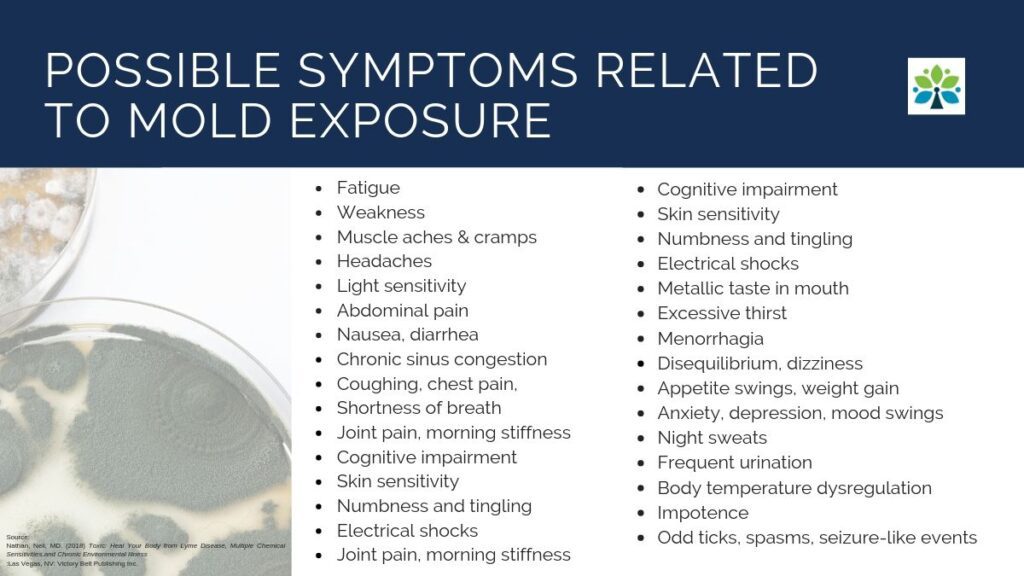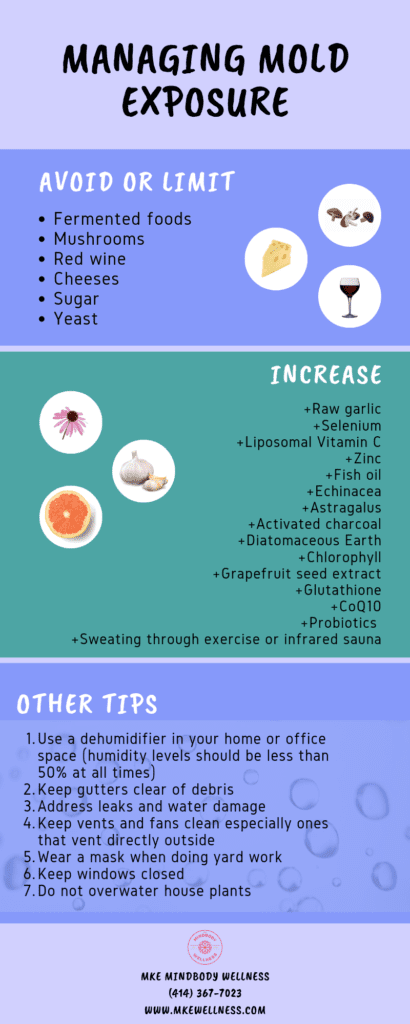Imagine this scenario: you arrive at your office, ready to tackle another day of work. As you settle in, you notice a musty smell lingering in the air. At first, it seems harmless, but over time, you start experiencing unexplained allergic reactions and respiratory issues. What you might not realize is that you could be suffering from mold exposure at work. In this article, we will explore the symptoms of mold exposure in the workplace and how to identify potential health risks. So, grab a cup of coffee and let’s delve into the importance of maintaining a healthy work environment.

Symptoms of Mold Exposure at Work: Identifying Workplace Health Risks
Mold exposure in the workplace can have serious health consequences for employees. Understanding the symptoms and risks associated with mold exposure is crucial for maintaining a safe and healthy work environment. In this article, we will explore what mold is, how it grows, common types of workplace mold, potential sources of mold in the workplace, the health risks associated with mold exposure, identifying symptoms of mold exposure, seeking medical attention, preventing mold exposure, and reporting incidents of mold exposure in the workplace.
1. Understanding Mold Exposure
1.1 What is Mold?
Mold is a type of fungus that thrives in moist, warm environments. It reproduces by releasing tiny spores into the air, which can be easily inhaled. While mold is present both indoors and outdoors, excessive mold growth indoors can lead to health problems.
1.2 How Does Mold Grow?
Mold requires three key elements to grow: moisture, a food source, and the right temperature. When these conditions are met, mold can start to grow on various surfaces, including walls, carpets, furniture, and even ventilation systems. Mold can spread rapidly if not addressed promptly, posing a risk to the health of employees in the workplace.
2. Common Types of Workplace Mold
2.1 Aspergillus
Aspergillus is a common type of mold found in the workplace. It can grow on various materials, such as drywall, insulation, and textiles. Exposure to Aspergillus can trigger allergic reactions and respiratory problems, particularly in individuals with weakened immune systems.
2.2 Stachybotrys Chartarum (Black Mold)
Stachybotrys Chartarum, also known as black mold, is a particularly concerning type of mold due to its potential health risks. It thrives in areas with excessive moisture and can often be found in water-damaged buildings. Black mold exposure has been linked to respiratory issues, allergic reactions, and even more severe health complications in some cases.
2.3 Cladosporium
Cladosporium is another common type of workplace mold that can grow on various surfaces, including damp carpets, fabrics, and wood. Exposure to Cladosporium can lead to respiratory symptoms such as wheezing, coughing, and shortness of breath.
2.4 Penicillium
Penicillium is a mold that is known for its distinctive blue and green appearance. It can commonly be found in water-damaged buildings and can produce mycotoxins that may cause respiratory problems, allergic reactions, and even more serious health effects in individuals with compromised immune systems.
2.5 Alternaria
Alternaria is a type of mold often found in damp or wet areas such as showers and leaky pipes. Exposure to Alternaria spores can trigger allergic reactions, asthma attacks, and other respiratory symptoms.
3. Sources of Mold in the Workplace
3.1 Water Leaks and Moisture Issues
Water leaks and moisture issues are common sources of mold growth in the workplace. Leaky pipes, roof leaks, and poor building maintenance can create conditions that promote mold growth, putting employees at risk.
3.2 HVAC Systems
HVAC (Heating, Ventilation, and Air Conditioning) systems play a crucial role in maintaining a comfortable and healthy indoor environment. However, if not properly maintained, HVAC systems can become breeding grounds for mold and circulate mold spores throughout the workplace.
3.3 Poor Ventilation
Inadequate ventilation can contribute to increased humidity and moisture levels, creating an environment conducive to mold growth. Poorly ventilated areas such as bathrooms, kitchens, and basements are particularly susceptible to mold growth.
3.4 Flooding and Water Damage
Flooding and water damage can introduce large amounts of moisture into the workplace, leading to rapid mold growth if not addressed promptly. It is important to properly dry and repair areas affected by flooding to prevent mold from spreading.
3.5 Damp Materials and Surfaces
Damp materials and surfaces, such as wet carpets, damp walls, and improperly stored items, can provide the ideal conditions for mold growth. Regular inspections and prompt action to address any signs of dampness are essential to prevent mold from becoming a problem.

4. Health Risks Associated with Mold Exposure
4.1 Allergic Reactions
Exposure to mold can trigger allergic reactions in some individuals. Symptoms may include sneezing, runny nose, itchy eyes, and skin rashes. Allergic reactions can vary in severity and may range from mild discomfort to more severe respiratory symptoms.
4.2 Respiratory Issues
Mold spores can irritate the respiratory system, leading to symptoms like coughing, wheezing, and shortness of breath. Individuals with pre-existing respiratory conditions, such as asthma, may experience more severe respiratory issues when exposed to mold.
4.3 Asthma Attacks
For individuals with asthma, exposure to mold can trigger asthma attacks. Asthma symptoms can become more frequent and severe when exposed to mold spores, leading to difficulty breathing and increased reliance on asthma medication.
4.4 Sinus Infections
Repeated exposure to mold can contribute to chronic sinus infections. The symptoms of a sinus infection include facial pain, pressure, congestion, and headaches.
4.5 Skin Irritation
Direct contact with mold or its spores can cause skin irritation, leading to rashes and hives. Itchy skin and redness are common symptoms associated with mold-related skin irritation.
4.6 Headaches and Fatigue
Prolonged exposure to mold can result in persistent headaches and fatigue. These symptoms can affect an individual’s ability to concentrate and perform tasks effectively, impacting their overall well-being and productivity.
5. Identifying Symptoms of Mold Exposure
5.1 Nasal Congestion and Runny Nose
One of the most common symptoms of mold exposure is nasal congestion and a runny nose. If you find yourself constantly reaching for tissues or experiencing difficulty breathing through your nose while at work, it may be a sign of mold presence.
5.2 Sneezing and Itchy Eyes
Frequent sneezing and itchy, watery eyes can be indicators of mold exposure. If you notice that your allergy-like symptoms are worse while at work and improve when you leave the workplace, mold exposure could be the culprit.
5.3 Coughing and Wheezing
Persistent coughing and wheezing are symptoms commonly associated with mold exposure. If you find yourself coughing excessively or experiencing difficulty breathing while at work, it is essential to consider the possibility of mold presence in your workspace.
5.4 Shortness of Breath
Shortness of breath is a more severe symptom that may indicate a significant mold exposure. If you experience difficulty breathing or feel like you cannot catch your breath while at work, it is crucial to take the issue seriously and seek medical attention.
5.5 Skin Rashes and Hives
If you notice unexplained skin rashes, redness, or hives that seem to worsen while at work and improve when away from the workplace, it may be a sign of mold exposure. Direct contact with mold or its spores can cause skin irritation.
5.6 Persistent Headaches and Fatigue
Frequent headaches and persistent fatigue can be symptoms of mold exposure. If you find it challenging to focus and experience unusual fatigue that seems to be linked to your time spent at work, mold exposure could be a potential cause.
5.7 Decreased Cognitive Function
Mold exposure can impact cognitive function, leading to difficulty concentrating, memory problems, and overall reduced productivity. If you find yourself struggling to stay focused and perform tasks as efficiently as before, it may be worth considering mold exposure as a contributing factor.

6. Seeking Medical Attention for Mold Exposure
6.1 Consultation with a Healthcare Professional
If you suspect that your symptoms are related to mold exposure at work, it is important to consult with a healthcare professional. They can evaluate your symptoms, review your medical history, and provide guidance on potential next steps.
6.2 Diagnostic Tests and Evaluations
Medical professionals may recommend diagnostic tests and evaluations to confirm the presence of mold exposure and assess its impact on your health. These tests may include allergy testing, lung function tests, and samples taken from your workplace environment.
6.3 Treatment Options
Treatment options for mold exposure will depend on the severity of your symptoms and the extent of mold exposure. It may include allergen avoidance, medications to manage symptoms, and in some cases, specialized treatments for more severe health complications.
7. Preventing Mold Exposure in the Workplace
7.1 Regular Maintenance and Inspections
Regular maintenance and inspections of the workplace are essential to identify and address potential sources of mold growth. Promptly fixing water leaks, repairing damaged areas, and ensuring proper ventilation can significantly reduce the risk of mold growth.
7.2 Addressing Water Leaks and Moisture Issues
Any water leaks or moisture issues should be promptly addressed to prevent the growth of mold. Timely repairs, proper drying, and moisture control measures are crucial for minimizing the risk of mold growth in the workplace.
7.3 Proper Ventilation and Air Circulation
Good ventilation and air circulation can help prevent excessive moisture buildup and reduce the likelihood of mold growth. Ensuring that HVAC systems are properly maintained and regularly serviced can contribute to maintaining a healthy indoor environment.
7.4 Cleaning and Disinfecting
Thorough cleaning and disinfection of the workplace can help remove mold spores and prevent their growth. Regular cleaning practices should be implemented, following appropriate protocols and using suitable cleaning agents for mold prevention.
7.5 Employee Education and Awareness
Educating employees about the risks of mold exposure and the importance of early identification can empower them to take proactive measures. Regular training sessions and communication about mold prevention strategies can contribute to creating a healthier work environment.

8. Reporting Mold Exposure in the Workplace
8.1 Internal Reporting Procedures
Employees should be aware of the internal reporting procedures established by their organization for incidents of mold exposure. Reporting any signs of mold growth or symptoms related to mold exposure promptly can initiate necessary actions to address the issue effectively.
8.2 Involvement of Health and Safety Departments
The involvement of health and safety departments in addressing incidents of mold exposure is crucial. These departments can conduct investigations, assess the risks, and implement appropriate measures to prevent further mold growth and protect the health of employees.
8.3 Legal Rights and Protections
Employees have legal rights and protections when it comes to mold exposure in the workplace. Familiarizing yourself with these laws and regulations can help ensure that your employer takes the necessary steps to address mold-related health risks appropriately.
10. Conclusion
Identifying and addressing mold exposure in the workplace is essential to safeguard the health and well-being of employees. By understanding the symptoms of mold exposure, recognizing potential sources of mold growth, and taking proactive measures to prevent its occurrence, employers and employees can create a safer and healthier work environment. Reporting incidents of mold exposure promptly and seeking appropriate medical attention when necessary is crucial for ensuring that any potential health risks are addressed efficiently. With proper awareness, education, and collaboration, the risks associated with mold exposure at work can be minimized, promoting the overall well-being of everyone in the workplace.
